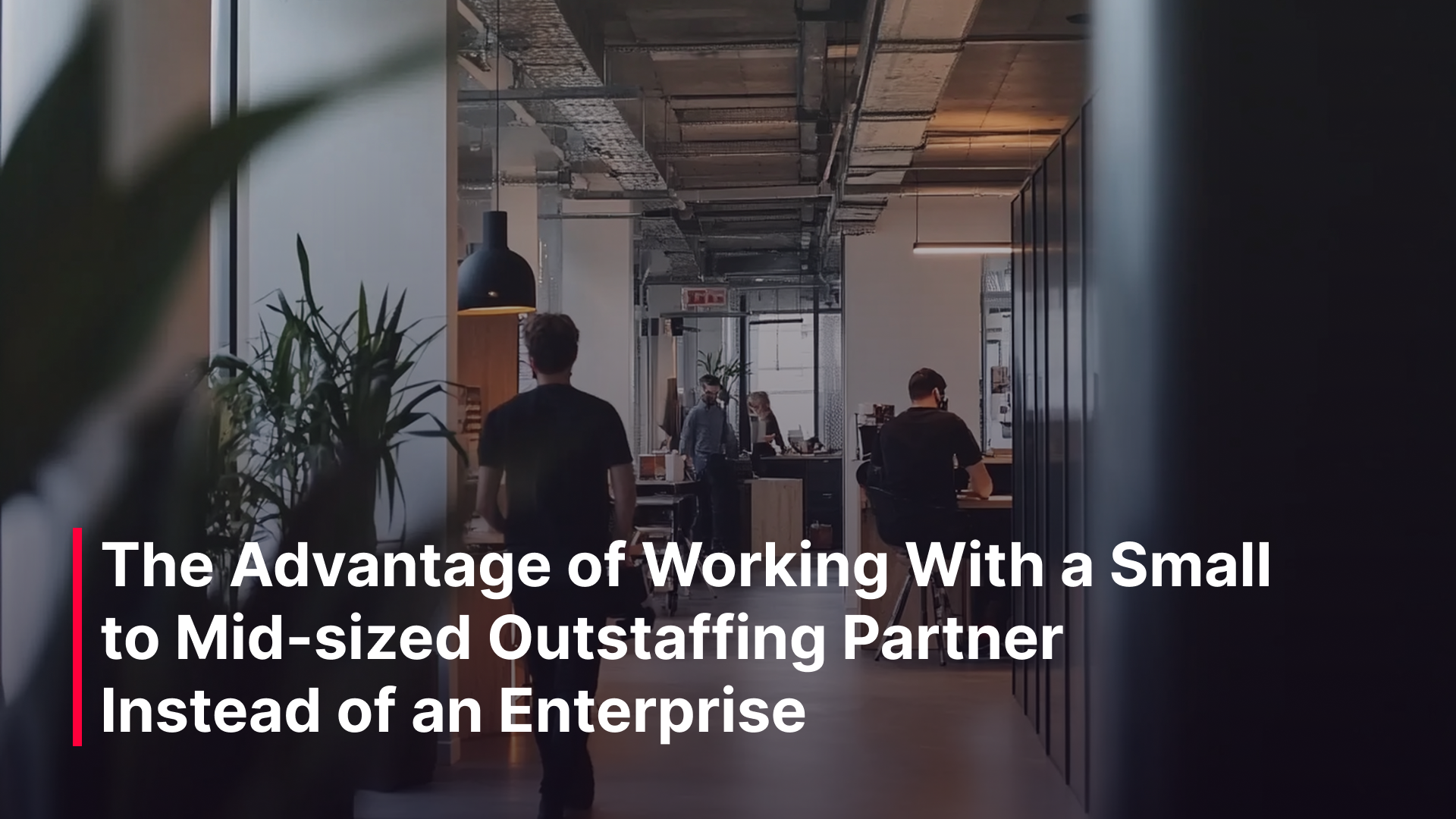Why a mid-sized outstaffing partner? When it comes to outsourcing critical tech functions, both in fast-growing startups and large enterprise departments, there’s a common assumption that partnering with a large, well-established enterprise provider is the safest bet.
It might seem logical—bigger vendors come with name recognition, abundant resources, and established processes.
However, particularly in scaling companies, the advantages of partnering with a small to mid-sized outstaffing provider are often overlooked, although some of them can directly address the pain points of managing complex projects or scaling their development teams head-on and more easily.
The Assumption of Enterprise Partners: Why Bigger Isn’t Always Better
The first argument here is the one of predictability and stability.
When you’re working with a large outsourcing provider, you’re often one of many clients, and the teams you work with can change as quickly as your project’s scope. High attrition rates, fluctuating costs, and shifting priorities can lead to inconsistent results and require constant oversight.
With a smaller partner, the opposite is true – the teams stay stable, delivering consistent results over time. Your partner is more likely to invest in ensuring that the team you start with is the team that sticks with you, minimizing disruptions and ensuring that expertise grows alongside your project.
Speeding Up Without Sacrificing Quality
This type of predictability is also about cost transparency. A mid-sized partner will commit to delivering the project within the budget you agreed, without unexpected spikes or overhead.
On top of this, it’s a time saver.
Time, as any tech leader would agree, is one of the most valuable resources, and a smaller outstaffing partner will more likely excel at getting projects up and running quickly without compromising quality. It’s not just their reputation that depends on this, but the core of that business.
This ranges from streamlining onboarding, to offering a rapid understanding of your specific business needs, and ramping up production in a fraction of the time a larger company might take to mobilize their resources. A solid collaboration is about being able to provide high-quality outputs early on in the partnership, which reduces the learning curve and allows your in-house teams to focus on strategy rather than management.
Independence and autonomy of a mid-sized outstaffing partner are also among our customers’ favorite reasons to work with mid-sized service providers.
You don’t need to micromanage the outsourced team, if you make sure there’s a model that emphasizes self-management in place. When your teams take accountability for their sprint completion and project milestones with minimal oversight required from your side, it translates into reduced management effort for you and, by extension, lower internal costs. There’s a reason why knowing how to deliver autonomously while ensuring alignment with your goals is one of the first tests for a solid long term collaboration.
On top of this, a mid-sized outsourcing company is often better positioned to provide these benefits than a large enterprise because of its inherent agility and customer-centric focus. Personalized service is more achievable with a smaller, dedicated team from a mid-sized outstaffing partner that can take the time to deeply understand the specific needs of a project. In larger enterprises, clients may get lost in a bureaucratic structure, where standardization takes precedence over customization.
In contrast, mid-sized companies are more nimble and adaptable, able to offer tailored solutions that align with the goals and technical requirements of every customer.
Less Oversight, More Ownership
Accountability is another central quality to how your outsourced team should operate.
Building a true partnership means being proactive in addressing challenges, transparent in communication, and fully aligned with your goals from the outset.
And in order for this to happen, another crucial factor is communication. It’s an issue that tends to get downplayed in discussions about outstaffing, but it’s one of the most critical aspects of any successful partnership. Understanding the core business needs and the specifics of every project shouldn’t be about good English in 2024, but about understanding your business language.
When it comes to dealing with project limitations, mid-sized partners are often more flexible. Large enterprises may have established processes that make adjusting to changing budgets, timelines, or technical constraints more difficult. Mid-sized providers, however, can offer more flexible engagement models and are often more open to working within the limitations of a specific project.
The ability to adapt to changes that arise after a contract is another advantage. Enterprise providers are generally tied down by complex, multi-layered processes that slow their ability to pivot or make real-time adjustments. Mid-sized partners, on the other hand, are typically structured to allow for quicker decision-making and greater operational flexibility.
This means that if the scope changes, new technologies need to be integrated, or market conditions shift, mid-sized partners can respond with agility, keeping projects on track without the delays that often accompany larger, more cumbersome organizations.
Moreover, customized flexibility in managing unexpected challenges is much easier to achieve with a mid-sized partner. Their teams tend to have more direct involvement from senior management, which allows for quicker escalations and faster resolutions when issues arise. Larger enterprises often have layers of approval and more rigid frameworks, which can slow down the process of making necessary adjustments. A mid-sized company can shift resources, adjust timelines, and adopt new strategies on the fly, ensuring that the project remains aligned with your business goals even as circumstances change.
Fostering long term success with a mid-sized outstaffing partner
Finally but just as important, what sets a smaller provider apart from enterprise-level outsourcing firms is culture and values.
Large corporations can feel impersonal, and often, your project is just one of many in their portfolio. A smaller team will cultivate empathy and a sense of shared values. You’ll find more flexibility, approachability, and personal investment in the success of your project.
We’ve seen this time and again, where our colleagues see themselves as an extension of your team and perform accordingly, sharing your goals and understanding your pressures.
Conclusion
It’s understandable that larger outsourcing companies may seem like the go-to option, because they pass the first credibility check. But the value of a smaller, more agile, and personally invested outstaffing partner shouldn’t be underestimated.
Whether you’re scaling a startup or leading a critical department within a global enterprise, the combination of predictability, accountability, clear communication, and shared values can make all the difference in delivering results.


